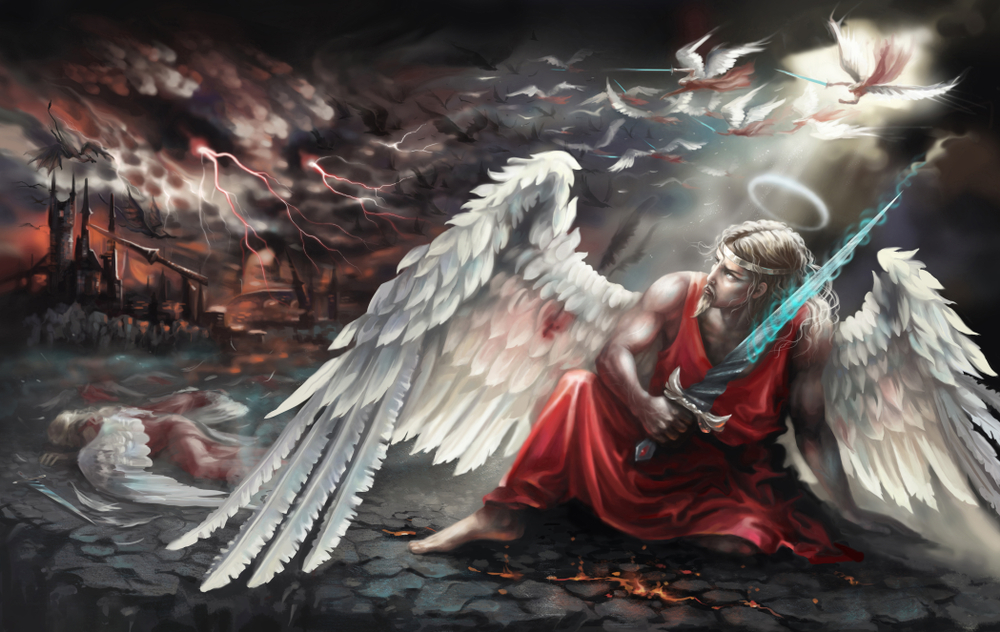

Senior Pastor at Sound of Heaven
ANSWER- According to the Bible, angels look like radiant, ethereal beings with wings, emanating an overwhelming aura of light. They typically have a human-like appearance, with their grand wings symbolizing their divine authority and capacity for swift mobility. They can also appear as mighty warriors and can also look just like you. There are also instances where the word Angel (Aggelos) is used and it is just referencing a messenger that was sent by God (a Human).
Angels have perennially fascinated humanity, sparking curiosity and wonder. Across various cultures and religions, they are seen as divine intermediaries, messengers of God or celestial beings of protection. This fascination stems not just from their ethereal beauty but also from their symbolic significance. They represent hope, divine intervention, and spiritual guidance to many, provoking an enduring fascination that permeates literature, art, and popular culture. Defining their appearance, however, remains a topic of much debate and interpretation.
In our quest to understand the celestial and the divine, the question often arises, “what do angels look like?” The mystery surrounding their appearance has intrigued spiritual seekers, artists, and scholars alike. Their depiction varies greatly across different cultures and religious texts, shrouded in symbolism and interpretation. Some portray angels with wings, symbolizing their swift, transcendent nature, while others depict them as radiant beings of light, representing their purity and divinity. Still, others illustrate angels as figures very similar to humans, embodying their close relationship with mankind. This ambiguity and diversity in representation only adds to the enchantment and intrigue of understanding what angels truly look like.
In the Judeo-Christian traditions, the Bible portrays angels in a strikingly different light, challenging our conventional depictions. Biblical accounts rarely describe angels with the ethereal beauty and ornate wings so common in contemporary artistic representations. Instead, they are often described as intimidating figures that invoke awe and fear. The book of Ezekiel describes the Cherubim, a type of angel, as creatures with four faces – that of a man, a lion, an ox, and an eagle – and four wings covered in eyes. Similarly, the book of Revelation describes the Seraphim, another type of angel, as beings with six wings and full of eyes all around and within.
The Bible uses vivid, metaphorical language to convey the otherworldly nature and immense power of these celestial beings. The unusual and diverse images of angels in the Bible underscore their mystical character and serve to further emphasize their role as divine messengers and servants of God. These descriptions remind us that angels belong to a reality far beyond our human understanding and perception, and their appearance defies human categorization and artistic representation.
In Islam, angels are regarded as beings created from light, invisible to the human eye yet present in our world. They are perceived as pure and incapable of sin, faithfully serving their given tasks such as recording deeds of humans, bringing revelations to prophets, or taking souls at the time of death. The Archangel Gabriel, known as Jibril in the Islamic tradition, is a key figure who delivered the words of the Quran to the Prophet Muhammad.
In Hindu mythology, the concept of angels, as we understand it from the Abrahamic religions, doesn’t directly apply. However, there are divine celestial beings known as Devas and Apsaras, who share similarities with the concept of angels. Devas are benevolent supernatural beings, often tasked with maintaining elements of the cosmos, while Apsaras are beautiful female spirits associated with water and the arts.
Buddhism recognizes the existence of heavenly beings called devas, but they are very different from the Western concept of angels. Devas are considered to be living beings dwelling in higher realms of existence due to their good karma, yet they are still part of the cycle of rebirth.
Zoroastrianism, an ancient Persian religion, speaks of divine entities called Amesha Spentas and Yazatas, who hold functions akin to angels. Amesha Spentas are seven divine emanations of Ahura Mazda, the supreme deity, while Yazatas are a broad spectrum of lesser deities or angels, often associated with natural phenomena.
These varying interpretations reflect the diversity of human culture and spirituality. Despite differences in their depictions, angels or similar beings are a universal symbol of the divine connection between the heavens and the earth.
The portrayal of angels in art, literature, and popular culture has been the product of centuries of societal evolution, religious interpretation, and artistic expression. In the realm of art, the angelic image has been depicted in countless forms, each reflecting the beliefs, sentiments, and aesthetics of the time. Interestingly, the image of angels with wings, a common feature in today’s depictions, was not commonplace until the middle ages. The artists of this period started illustrating angels with wings to symbolize their divine nature and their ability to traverse between heaven and earth.
In literature, angels often serve as divine messengers, ethereal guides, or harbingers of doom. They are characterized by their wisdom, compassion, and formidable power, reflecting their divine origins. For instance, in Dante’s “Divine Comedy,” angels are depicted as guides, aiding Dante in his celestial journey through Hell, Purgatory, and Heaven.
Popular culture, too, has embraced the image of angels. They’ve been featured in countless movies, TV shows, comic books, and songs, often symbolizing hope, love, and the divine. In some instances, pop culture even explores the idea of fallen angels, beings who were once divine but have lost their grace. This notion captures the human struggle with morality and the concept of redemption, thus further enriching the angelic narrative.
Regardless of the medium, the portrayal of angels is a testament to humanity’s eternal quest for understanding the divine and the unseen. Their image serves as a beacon of hope and a reminder of the spiritual dimension that many believe coexists with our physical world.
The Bible often employs metaphorical and symbolic language to depict the elusive ethereal beauty and divine aura of biblically accurate angels. In the Christian tradition, the question “what do biblically accurate angels look like?” is answered with a variety of descriptions throughout scripture. In the Old Testament, the prophet Daniel describes a biblically accurate angel as a man dressed in linen, with a belt of fine gold and a body like chrysolite, and a face like lightning, eyes like flaming torches, arms and legs like the gleam of burnished bronze, and a voice like the sound of a multitude (Daniel 10:5-6). This biblically accurate description alludes to the radiant, awe-inspiring presence of angels and their celestial origin.
The New Testament, on the other hand, tends to describe angels as appearing in human form. For instance, in the book of Luke, the angel Gabriel visits Mary and is not described visually but communicates like a human, delivering a message from God (Luke 1:26-38). This suggests that, while angels are divine beings, they can adopt human-like appearances to interact with mankind. Answering the question “what do angels look like?” in the context of the New Testament would then involve a more human image, albeit one that is still shrouded in divine mystery.
The diversity in descriptions of angels within the Bible reflects the complex and multifaceted nature of these celestial beings. The variety of interpretations intended to answer “what do angels look like?” allows for an understanding of angels that is not bound by human physicality. Instead, it paints a picture of divine messengers whose appearance transcends human comprehension, and whose true forms are as varied and vast as the faiths and cultures that seek to understand them.

The Bible often characterizes angels as luminous and awe-inspiring beings, highlighting their divine origin and celestial nature. For instance, in the book of Matthew, an angel is described as having an appearance like lightning, and clothes as white as snow (Matthew 28:2-3). This description underscores the radiant, majestic presence of angels and their ability to inspire awe and reverence. Likewise, in the book of Daniel, an angel’s body is likened to topaz, a precious gemstone, suggesting a form that is beautiful, radiant, and precious (Daniel 10:5-6). These examples demonstrate the Bible’s tendency to depict angels in terms of light, purity, and precious materials, emphasizing their divine beauty and otherworldly nature.
Additionally, the Bible often describes angels as having wings, symbolizing their swiftness and ability to traverse different realms. In the Book of Revelation, celestial creatures referred to as Seraphim are depicted as having six wings (Revelation 4:8). Similarly, the Cherubim in the book of Ezekiel are described as having four wings (Ezekiel 10:14). The presence of wings not only underscores their ethereal nature but also signifies their role as divine messengers, capable of bridging the gap between the divine and the human realms.
Another common characteristic attributed to angels in the Bible is the ability to appear in human form. For example, the angel Gabriel, who appears to Mary in the book of Luke, communicates with her in a human-like manner, delivering a divine message (Luke 1:26-38). This implies that angels, though celestial beings, can assume a human-like appearance to interact with mankind. This human-like depiction underscores the close connection between the divine and human realms and reflects the Bible’s portrayal of angels as divine intermediaries.
Near-death experiences often provide insightful narratives that align with the biblical descriptions of angels, further enriching our exploration of “what do angels look like?”. These personal accounts consistently describe encounters with radiant, ethereal beings, symbolizing hope, guidance, and divine reassurance.
For instance, one compelling account is from a heart attack survivor named John. He recalls encountering a being of overwhelming light and warmth during his near-death experience. John describes the being as having a human appearance but emanating an intense light from its being. This depiction resonates with biblical descriptions, particularly the radiant presence and human-like form of angels.
Another individual, Sarah, who had a near-death experience during a severe car accident, shared her encounter with a being that she believed was an angel. She described the being as a radiant figure surrounded by a soft, glowing light. The figure had wings that sparkled like diamonds, further emphasizing the angel’s ethereal beauty. Sarah’s description aligns with the biblical imagery of angels symbolized by light and precious gemstones.
Finally, there’s the story of Emily, who during a severe illness, claimed to have seen an angelic figure standing at the foot of her bed. The figure had a human form but was surrounded by an intense light and had a sense of an extraordinary, divine aura about it. This encounter mirrors the New Testament’s descriptions of angels appearing in a comprehensible, human-like form yet still shrouded in divine mystery.
These personal stories, drawn from near-death experiences, offer a deeper perspective on “what do angels look like?”. While the experiences are subjective and personal, they consistently align with the biblical descriptions, illustrating the enduring influence of religious texts on our understanding of the celestial and the divine.
Experiencing a near-death encounter or an interaction with an angel can be a transformative event, leading to profound changes in one’s outlook on life. For some, it may reinforce previous faith-based beliefs, while for others, it can initiate a spiritual awakening.
Firstly, such experiences can provide individuals with a newfound sense of purpose, fostering the belief that their survival wasn’t an accident but a divine intervention. This can lead to a heightened appreciation of life, along with a greater motivation to make positive changes or to serve others.
Secondly, near-death or angelic encounters can instill a newfound faith in Jesus and Christianity. Individuals who previously identified as agnostic, atheist, or were unsure of their religious beliefs may find themselves drawn towards Christianity. The appearance of angelic beings, considered as messengers of God, can substantiate the teachings of the Bible, thus inspiring faith in Jesus.
Thirdly, the comforting presence and divine reassurance often associated with these encounters can alleviate fears of death and the afterlife. This peace often brings a renewed hope and faith in God and Jesus Christ, strengthening the belief in eternal life and divine salvation.
Lastly, these transformative experiences can lead to profound lifestyle changes. Some individuals may feel called to share their experiences with others, aiming to impart hope and faith. Others may feel a desire to delve deeper into religious teachings, attend church more regularly, or engage in activities that embody Christian teachings.
In essence, near-death experiences and angelic encounters can profoundly impact an individual’s life, potentially starting them on a path towards faith and belief in Jesus Christ. Such experiences can foster a newfound respect for life, a deeper understanding of spirituality, and a devoted faith in Jesus, further solidifying their relationship with Christianity.
In conclusion, the descriptions of angels, whether they come from biblical texts or personal near-death experiences, present a fascinating blend of the familiar and the mysterious. The divine beauty, radiant presence, ethereal nature, and human-like forms of angels invite us to expand our understanding beyond physical appearances, embracing the inherent mystery and diversity that characterize these celestial messengers. Every depiction of an angel is a testament to the profound ways in which they touch human lives, offering guidance, hope, and divine reassurance. So, let us continue to engage with these narratives, exploring and cherishing the multifaceted nature of angels, while also acknowledging and embracing the divine mystery that surrounds them.
Pray With Me
Dear Heavenly Father,
I come before You, acknowledging Your greatness and the magnificence of Your creation. I am humbled by Your love, which transcends all understanding, and Your mercy, which is new every morning. In this moment, I accept Jesus Christ as my Lord and Savior. I confess with my mouth and believe in my heart that Jesus died for my sins and was raised from the dead for my salvation. I surrender my life to You, Lord, and commit to walking in Your ways, guided by Your Holy Spirit.
Lord, I open my heart to the spiritual realities of angels and the supernatural. I believe in Your heavenly messengers, the angels, and their divine role as revealed in Your holy scriptures. Open my spiritual eyes, Lord, to behold and understand the marvelous workings of Your celestial servants. Allow me to experience their protective, guiding presence in my life, and help me to recognize and appreciate their divine interactions.
Lastly, I ask for Your divine wisdom to navigate this journey of faith. Strengthen my resolve to live a life that reflects Your teachings and radiates Your love, grace, and mercy. Unfold the spiritual realities of Your kingdom in my life, that I may live in awe and reverence of Your divine power and providence. In Jesus’ name, I pray.
Amen.
© Sound of Heaven Church 2011- 2024